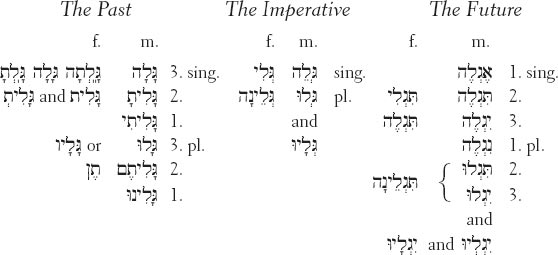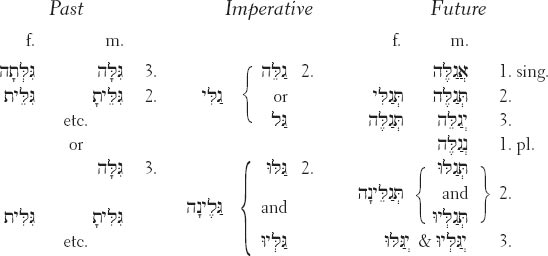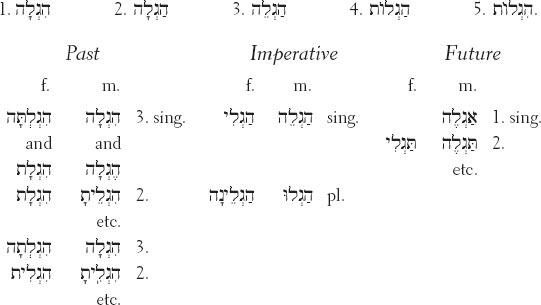 )
) )
)This conjugation consisting of verbs ending in  does not differ much from the preceding one; indeed it conforms with it very often. This is because the
does not differ much from the preceding one; indeed it conforms with it very often. This is because the  may frequently serve in place of the
may frequently serve in place of the  , and contrarily the
, and contrarily the  may frequently serve in place of the
may frequently serve in place of the  . They differ only in that while a verb ending in
. They differ only in that while a verb ending in  most frequently retains it and only rarely does it change the
most frequently retains it and only rarely does it change the  into a chirek in the second and first persons, on the other hand, those ending in a
into a chirek in the second and first persons, on the other hand, those ending in a  rarely retain it, and they are frequently wont to change the
rarely retain it, and they are frequently wont to change the  into a long chirek and rarely into a short one. Next, they differ also in another way; the
into a long chirek and rarely into a short one. Next, they differ also in another way; the  may be punctuated with a
may be punctuated with a  and the verb is not punctuated by a double
and the verb is not punctuated by a double  but a
but a  and a
and a  , like the verbs of the first conjugation. Four verbs of this group have been observed; namely,
, like the verbs of the first conjugation. Four verbs of this group have been observed; namely,  ,
,  , which are conjugated like verbs of the first conjugation, and for this reason I consider them to be of that group.
, which are conjugated like verbs of the first conjugation, and for this reason I consider them to be of that group.
Further, certain of these verbs ending in  have a peculiarity which we will note in its place after the paradigm. Here may I add this in general to be heard by all: first, that a
have a peculiarity which we will note in its place after the paradigm. Here may I add this in general to be heard by all: first, that a  after a chirek and tsere and shurek usually changes to
after a chirek and tsere and shurek usually changes to  and after a
and after a  into a
into a  ; second, that a final
; second, that a final  either because of an additional syllable or on account of the construct changes into a
either because of an additional syllable or on account of the construct changes into a  ; and finally, that a quiescent and guttural letter usually interchange one for the other, or one may even omit them. Indeed, we have already shown above that a
; and finally, that a quiescent and guttural letter usually interchange one for the other, or one may even omit them. Indeed, we have already shown above that a  after a sheva frequently disappears. And that this may be observed in verbs, as in nouns, will be evident from the following paradigm.
after a sheva frequently disappears. And that this may be observed in verbs, as in nouns, will be evident from the following paradigm.
The infinitive has the following forms  , and
, and  , or with the paragogic
, or with the paragogic  .
.

We have already noted that an  can come in place of a
can come in place of a  , or be altogether omitted either in the first and second persons plural of the past and in all the futures, and that a yod is not substituted in its place, but it is conjugated like
, or be altogether omitted either in the first and second persons plural of the past and in all the futures, and that a yod is not substituted in its place, but it is conjugated like  . But this should be noted first, that when the
. But this should be noted first, that when the  is removed in the future its accent is moved toward its first syllable, and the sheva changes into a segol, becoming 1.
is removed in the future its accent is moved toward its first syllable, and the sheva changes into a segol, becoming 1.  , 2.
, 2.  , 3.
, 3.  , etc. But if the middle radical of the root is one of the mutes or quiescent letters, then the sheva remains, like
, etc. But if the middle radical of the root is one of the mutes or quiescent letters, then the sheva remains, like  in place of
in place of  to take captive, and
to take captive, and  to drink. When a
to drink. When a  is changed into a yod, then the vowels are transposed, and they are 1.
is changed into a yod, then the vowels are transposed, and they are 1.  , 2.
, 2.  , 3.
, 3.  , etc., in place of
, etc., in place of  .
.
Next, the  of the verb usually is changed not into a
of the verb usually is changed not into a  but into a yod when another
but into a yod when another  is added. So
is added. So  has the feminine
has the feminine  instead of
instead of  . So
. So  with the added paragogic
with the added paragogic  becomes not
becomes not  but
but  .
.
Finally, the second and third persons plural in the future  and
and  do not usually add the paragogic
do not usually add the paragogic  ; but their second form, i.e.,
; but their second form, i.e.,  and
and  , does, like
, does, like  , etc.
, etc.
Infinitive Forms

The Past

This verb form has nothing singular which we have not noted in the preceding one, except that by the dropping of the  of the future neither the accent nor the syllable changes. For with the dropped
of the future neither the accent nor the syllable changes. For with the dropped  it is conjugated 1.
it is conjugated 1.  , 2.
, 2.  , 3.
, 3.  , etc. I doubt whether the second and third persons of the plural always omit the
, etc. I doubt whether the second and third persons of the plural always omit the  , or, whether as in the active (kal), change it to a
, or, whether as in the active (kal), change it to a  . However, I believe that all the other things which we noted about the preceding ones pertain to this verb form.
. However, I believe that all the other things which we noted about the preceding ones pertain to this verb form.
The forms of the infinitive are:
 and with the
and with the  paragogic
paragogic 

This verb form also remains  in the future when the
in the future when the  is dropped, and the vowels are not changed. For the dropped
is dropped, and the vowels are not changed. For the dropped  makes it 1.
makes it 1.  , 2.
, 2.  , 3.
, 3.  , etc.
, etc.
Infinitives: 1.  2.
2.  or
or  .
.

In Chapter 17 we noted that a kametz chatuf can be used in place of a  . The verbs of this conjugation provide many examples of this, as in Proverbs chap. 24, vs. 31
. The verbs of this conjugation provide many examples of this, as in Proverbs chap. 24, vs. 31  its face was covered, and Psalms chapter 72 last verse
its face was covered, and Psalms chapter 72 last verse  the prayers are ended.
the prayers are ended.
The fact that the  , changes to a cholem, when the middle letter of the root cannot receive a dagesh, is similar to the verbs of the first conjugation; and I have not undertaken to note anything in this conjugation unless it differs with verbs of the first conjugation.
, changes to a cholem, when the middle letter of the root cannot receive a dagesh, is similar to the verbs of the first conjugation; and I have not undertaken to note anything in this conjugation unless it differs with verbs of the first conjugation.
The forms of its infinitive are:

The future and imperative, when the  is dropped, are punctuated with double segol, becoming
is dropped, are punctuated with double segol, becoming  instead of
instead of  , etc. But if the middle letter of the root is a mute or quiescent letter, then the
, etc. But if the middle letter of the root is a mute or quiescent letter, then the  remains, and
remains, and  changes into a
changes into a  like
like  for
for  he makes to drink, that is, he gives a drink,
he makes to drink, that is, he gives a drink,  for
for  he makes to see, or he shows, etc.
he makes to see, or he shows, etc.
As for the causative passive (hoph‘al)  and the reciprocal passive (hithpael),
and the reciprocal passive (hithpael),  , they are marked in the same way as the preceding ones in the present, imperative, and future, and they have nothing singular about them which I have not noted about the simple verbs (kal) of this conjugation.
, they are marked in the same way as the preceding ones in the present, imperative, and future, and they have nothing singular about them which I have not noted about the simple verbs (kal) of this conjugation.

1. [Term not used by Spinoza.—M.L.M.]
2. [Term not used by Spinoza.—M.L.M.]
3. [Term not used by Spinoza.—M.L.M.]
4. [Term not used by Spinoza.—M.L.M.]
5. [Term not used by Spinoza.—M.L.M.]